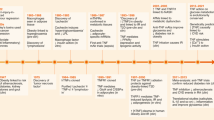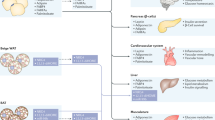Abstract
The scientific interest in the biology of white adipose tissue (WAT) has increased since the discovery of leptin in 1994. The description of the product of the gene obese (ob) demonstrated the role of adipose tissue in the physiopathology of obesity-related diseases, and helped to increase the identification of numerous other adipokines, many of a pro-inflammatory nature. It has become increasingly evident that WAT-derived adipokines can be considered as a hub between obesity-related exogenous factors, such as nutrition and lifestyle, and the molecular events that lead to metabolic syndrome, inflammatory and/or autoimmune conditions, and rheumatic diseases. In this Review, we will discuss the progress in adipokine research, focusing particular attention to the roles of leptin, adiponectin, resistin, visfatin, and other recently identified adipokines in inflammatory, autoimmune and rheumatic diseases.
Key Points
-
Adipokines are soluble factors produced prevalently by white adipose tissue that have emerged as modulators of inflammation and the immune response
-
Although definitive conclusions are awaited, recent evidence points to involvement of adipokines in relevant degenerative diseases such as rheumatoid arthritis and osteoarthritis
-
Although many functions of these molecules remain to be investigated, adipokines stand at the interface between metabolism and immunity in modulating not only inflammation, but also immune and autoimmune reactivity
This is a preview of subscription content, access via your institution
Access options
Subscribe to this journal
Receive 12 print issues and online access
$209.00 per year
only $17.42 per issue
Buy this article
- Purchase on Springer Link
- Instant access to full article PDF
Prices may be subject to local taxes which are calculated during checkout



Similar content being viewed by others
References
Zhang Y et al. (1994) Positional cloning of the mouse obese gene and its human homologue. Nature 372: 425–432
Otero M et al. (2005) Leptin, from fat to inflammation: old questions and new insights. FEBS Lett 579: 295–301
Fantuzzi G (2005) Adipose tissue, adipokines, and inflammation. J Allergy Clin Immunol 115: 911–919
Hotamisligil GS et al. (1993) Adipose expression of tumor necrosis factor-alpha: direct role in obesity-linked insulin resistance. Science 259: 87–91
Tilg H et al. (2006) Adipocytokines: mediators linking adipose tissue, inflammation and immunity. Nature Rev Immunol 6: 772–783
Dayer JM et al. (2006) Adipose tissue has anti-inflammatory properties. Ann NY Acad Sci 1069: 444–453
Otero M et al. (2006) Towards a pro-inflammatory and immunomodulatory emerging role of leptin. Rheumatology (Oxford) 45: 944–950
Fruhbeck G (2006) Intracellular signalling pathways activated by leptin. Biochem J 393: 7–20
Gualillo O et al. (2002) Leptin promotes the tyrosine phosphorylation of SHC proteins and SHC association with GRB2. Mol Cell Endocrinol 190: 83–89
Howard JK et al. (1999) Leptin protects mice from starvation-induced lymphoid atrophy and increases thymic cellularity in ob/ob mice. J Clin Invest 104: 1051–1059
Matarese G et al. (2005) Leptin in immunology. J Immunol 174: 3137–3142
Faggioni R et al. (2001) Leptin regulation of the immune response and the immunodeficiency of malnutrition. FASEB J 15: 2565–2571
De Rosa et al. (2007) A key role of leptin in the control of regulatory T cell proliferation. Immunity 26: 241–255
Otero M et al. (2006) Changes in plasma levels of fat-derived hormones adiponectin, leptin, resistin and visfatin in patients with rheumatoid arthritis. Ann Rheum Dis 65: 1198–1201
Toussirot E et al. (2007) The contribution of adipose tissue and adipokines to inflammation in joint diseases. Curr Med Chem 14: 1095–1100
Fraser DA et al. (1999) Decreased CD4+ lymphocyte activation and increased interleukin-4 production in peripheral blood of rheumatoid arthritis patients after acute starvation. Clin Rheumatol 18: 394–401
Bernotiene E et al. (2006) The role of leptin in innate and adaptive immune response. Arthritis Res Ther 8: 217–226
Gualillo O (2007) Further evidence for leptin involvement in cartilage homeostases. Osteoarthritis Cartilage 15: 857–860
Otero M et al. (2003) Synergistic induction of nitric oxide synthase type II: in vitro effect of leptin and interferon-gamma in human chondrocytes and ATDC5 chondrogenic cells. Arthritis Rheum 48: 404–409
Otero M et al. (2005) Signalling pathway involved in nitric oxide synthase type II activation in chondrocytes: synergistic effect of leptin with interleukin-1. Arthritis Res Ther 7: R581–R591
Simopoulou T et al. (2007) Differential expression of leptin and leptin's receptor isoform (Ob-Rb) mRNA between advanced and minimally affected osteoarthritic cartilage; effect on cartilage metabolism. Osteoarthritis Cartilage 15: 872–883
Iliopoulos D et al. (2007) Epigenetic regulation of leptin affects MMP-13 expression in osteoarthritic chondrocytes: possible molecular target for osteoarthritis therapeutic intervention. Ann Rheum Dis [doi:10.1136/ard.2007.069377]
Oh DK et al. (2007) Adiponectin in health and disease. Diabetes Obes Metab 9: 282–289
Kadowaki T et al. (2005) Adiponectin and adiponectin receptors. Endocr Rev 26: 439–451
Matsuzawa Y (2006) Therapy Insight: adipocytokines in metabolic syndrome and related cardiovascular disease. Nat Clin Pract Cardiovasc Med 3: 35–42
Schaffler A et al. (2003) Adipocytokines in synovial fluid. JAMA 290: 1709–1710
Sada KE et al. (2006) Altered levels of adipocytokines in association with insulin resistance in patients with systemic lupus erythematosus. J Rheumatol 33: 1545–1552
Ehling A et al. (2006) The potential of adiponectin in driving arthritis. J Immunol 176: 4468–4478
Lago R et al. (2007) Adiponectin induces nitric oxide synthase type 2 and pro-inflammatory cytokines in chondrocytes. Ann Rheum Dis 66 (Suppl 11): 142
Steppan CM et al. (2001) The hormone resistin links obesity to diabetes. Nature 409: 307–312
Harsch IA et al. (2004) Resistin levels in patients with obstructive sleep apnoea syndrome—the link to subclinical inflammation? Med Sci Monit 10: CR510–CR515
Reilly MP et al. (2005) Resistin is an inflammatory marker of atherosclerosis in humans. Circulation 111: 932–939
Lehrke M et al. (2004) An inflammatory cascade leading to hyperresistinemia in humans. PLoS Med 1: e45
Bokarewa M et al. (2005) Resistin, an adipokine with potent proinflammatory properties. J Immunol 174: 5789–5795
Senolt L et al. (2007) Resistin in rheumatoid arthritis synovial tissue, synovial fluid and serum. Ann Rheum Dis 66: 458–463
Fukuhara A et al. (2005) Visfatin: a protein secreted by visceral fat that mimics the effects of insulin. Science 307: 426–430
Jia SH et al. (2004) Pre-B cell colony-enhancing factor inhibits neutrophil apoptosis in experimental inflammation and clinical sepsis. J Clin Invest 113: 1318–1327
Moschen AR et al. (2007) Visfatin, an adipocytokine with proinflammatory and immunomodulating properties. J Immunol 178: 1748–1758
Tatemoto K et al. (1998) Isolation and characterization of a novel endogenous peptide ligand for the human APJ receptor. Biochem Biophys Res Commun 251: 471–476
Daviaud D et al. (2006) TNFalpha up-regulates apelin expression in human and mouse adipose tissue. FASEB J 20: 1528–1530
Xu H et al. (2003) Chronic inflammation in fat plays a crucial role in the development of obesity-related insulin resistance. J Clin Invest 112: 1821–1830
Hida K et al. (2005) Visceral adipose tissue-derived serine protease inhibitor: a unique insulin-sensitizing adipocytokine in obesity. Proc Natl Acad Sci USA 102: 10610–10615
Park CH et al. (2001) Hepcidin, a urinary antimicrobial peptide synthesized in the liver. J Biol Chem 276: 7806–7810
Bekri S et al. (2006) Increased adipose tissue expression of hepcidin in severe obesity is independent from diabetes and NASH. Gastroenterology 131: 788–796
Fleming RE (2007) Hepcidin activation during inflammation: make it STAT. Gastroenterology 132: 447–449
Pietrangelo A et al. (2007) STAT3 is required for IL-6-gp130-dependent activation of hepcidin in vivo. Gastroenterology 132: 294–300
Schaffler A et al. (2005) Genomic structure of human omentin, a new adipocytokine expressed in omental adipose tissue. Biochim Biophys Acta 1732: 96–102
Gerwick L et al. (2007) Gene transcript changes in individual rainbow trout livers following an inflammatory stimulus. Fish Shellfish Immunol 22: 157–171
de Souza Batista CM et al. (2007) Omentin plasma levels and gene expression are decreased in obesity. Diabetes 56: 1655–1661
Kuperman DA et al. (2005) Dissecting asthma using focused transgenic modeling and functional genomics. J Allergy Clin Immunol 116: 305–311
Karsenty G (2006) Convergence between bone and energy homeostases: leptin regulation of bone mass. Cell Metab 4: 341–348
Acknowledgements
Part of the research described in this Review was supported by the Spanish Ministry of Health through the Fondo de Investigación Sanitaria, Instituto de Salud Carlos III (contracts PI05/0525, PI030115, PI050419, PI060919 and G03/152), by the Spanish Ministry of Education & Science (BFU 2005) and/or by the Xunta de Galicia. The work of O Gualillo and F Lago is funded by the Instituto de Salud Carlos III and the Xunta de Galicia (SERGAS) through a research staff stabilization contract. The authors would like to thank R Gomez Bahamonde for his help with drawing tables and figures. Désirée Lie, University of California, Irvine, CA, is the author of and is solely responsible for the content of the learning objectives, questions and answers of the Medscape-accredited continuing medical education activity associated with this article.
Author information
Authors and Affiliations
Corresponding author
Ethics declarations
Competing interests
The authors declare no competing financial interests.
Rights and permissions
About this article
Cite this article
Lago, F., Dieguez, C., Gómez-Reino, J. et al. Adipokines as emerging mediators of immune response and inflammation. Nat Rev Rheumatol 3, 716–724 (2007). https://doi.org/10.1038/ncprheum0674
Received:
Accepted:
Issue Date:
DOI: https://doi.org/10.1038/ncprheum0674
This article is cited by
-
Antimicrobial protein REG3A regulates glucose homeostasis and insulin resistance in obese diabetic mice
Communications Biology (2023)
-
Possible Implications of Obesity-Primed Microglia that Could Contribute to Stroke-Associated Damage
Cellular and Molecular Neurobiology (2023)
-
Prevalence and characteristics of diffuse idiopathic skeletal hyperostosis (DISH) in Italy
La radiologia medica (2022)
-
COVID-19 Vaccines: Special Considerations for the Obese Population
Obesity Surgery (2021)
-
Sputum and plasma adiponectin levels in clinically stable adult cystic fibrosis patients with CFTR I1234V mutation
Translational Medicine Communications (2020)



